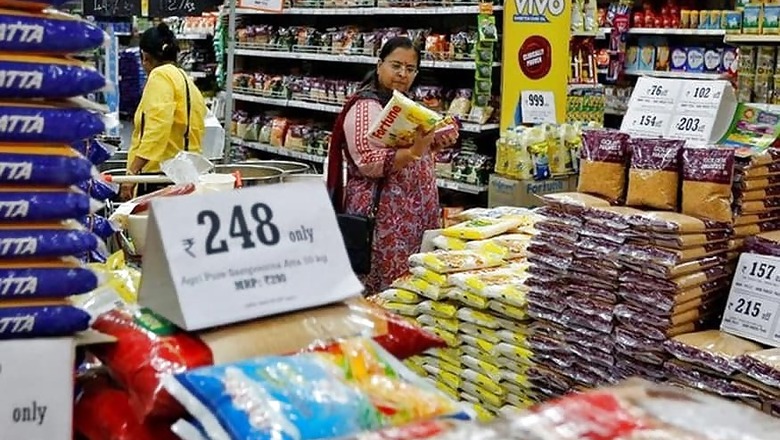
views
As India went into a sudden and complete lockdown from March 25 to stall the spread of COVID-19, an unintended fallout was increase in prices of many daily essentials.
April was the first full month when nearly all economic activity came at a standstill. Crores of Indian were forced to stay at home and since eating out was impossible, there were more home meals cooked than ever before.
As demand for daal, atta, rice, cooking oil and vegetables soared, retail prices of some of these essential items also rose in tandem due to supply side glitches.
According to data made available by the Consumer Affairs Department, the price at which one could buy tur (arhar) daal at a grocery shop in Delhi on April 15 had risen by Rs 6 (at Rs 101 per kg) within a fortnight. By April 30, another Rs 5 had been added to this retail price. With this, tur daal, a favourite among north Indians, became dearer by Rs 11 (at Rs 106 per kg).
In fact, the retail price of most pulses – moong, masur, chana and urad - had risen across kirana stores during April.
A large pulses’ trader had said at the time that shortage of labour (due to reverse migration) was affecting milling of pulses and overall supply to retailers had dwindled by about 30% in April. This had consequently led to 10-15% increase in retail prices during the month.
Data further revealed how milk prices inched up during the month with the average retail price across the country rising from Rs 45.80 per litre at the end of March to Rs 47.08 at the end of April. In some centres, the increase was much steeper.
These data underscore the significant inflation concerns expressed by the Monetary Policy Committee of the Reserve Bank of India (RBI). The MPC has said in its latest comments that the inflation outlook for the rest of the year is “highly uncertain” but food inflation is likely to moderate in the coming months as supply constraints ease.
According to data from the Ministry of Statistics and Programme Implementation, food inflation rose to 8.6% in April from 7.8% in the previous month even when headline inflation softened during the period.
Inflation in prices of vegetables was registered at 23.6% -- veggies became dearer by a fourth -- in April against a four-month low of 18.6% in the immediately previous month.
Inflation in cereals and products increased to a nearly six-year-high of 7.8% from 5.3% over the same period, according to official data.
It is important to note that for April, the Statistics Ministry had released data on selected sub-groups (food and beverages, excluding meat and fish, and prepared meals, and snacks) since the month had seen limited transactions in retail items other than food.
Also, while the consensus of MPC was that food inflation would cool down going forward, committee member Chetan Ghate differed.
He said the food inflation in April “will likely remain elevated in the coming months. This is worrisome. I continue to be concerned about declining market arrivals of food commodities because of COVID-related supply side bottle-necks and their inflationary impact.”
If the monsoon rains are normal and supplies improve, food inflation may cease to worry. The heated food inflation in April came on the back of moderated retail inflation print in March, when ironically, a decline in retail food prices had helped.
Meanwhile, analysts at ratings agency Crisil have noted that food inflation was a key concern in 2019-20 for the RBI’s inflation-targeting policy since it began rising in April after almost six years.
“Similar concerns have cropped up again, at least for the time being. After softening a little bit in March 2020, retail food inflation again flared up in April – the first full month of the nationwide lockdown. From 8.8% in March, food inflation rose to 10.5% in April. While the rise was broad-based, vegetables and pulses saw particularly high inflation at 23.6% and 22.8%, respectively.
“Another divergent aspect of food inflation is the rise is retail food inflation, even as it softens at the wholesale level. From 5.5% in March, wholesale food inflation was down at 3.6% in April. This suggests that the firming-up of retail food inflation can largely be attributed to supply related disruptions because of the lockdown. Once the situation normalises, retail food inflation can be expected to soften. A bumper rabi harvest and higher kharif target – because of a forecast for a normal monsoon – are likely to keep a tab on food inflation.”
So have things improved since April? DK Srivastava, Chief Policy Advisor at EY, said the uncertainty the RBI has spoken of in the context of inflation stems from macro measures and he expected food inflation to ease in the coming months.
“Overall, uncertainty on inflation is driven by macro-economic measures – interest rates have been driven down, there is surplus liquidity in the system. When economy has to be revived through monetary stimulus, both output and inflation are driven upwards. The extent of recovery in output in remaining parts of the year will indirectly check overall inflation.”
Srivastava said several factors could help in keeping food inflation in check going forward: good monsoons aiding kharif sowing, the recent government decision to create an all-India agri-market and continued softness in global crude prices.




















Comments
0 comment